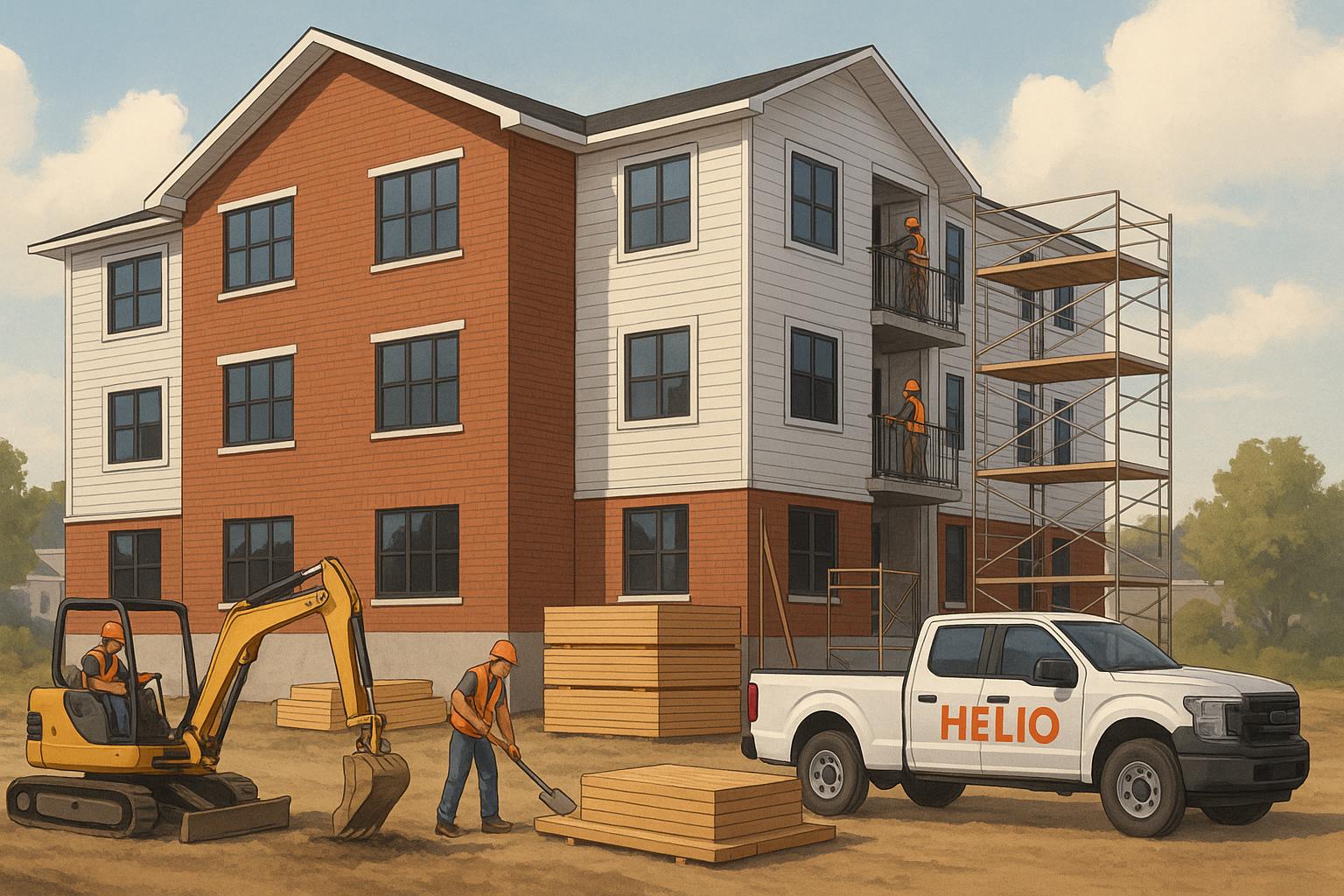In Halifax, property taxes for multi-unit rental properties are calculated using the income approach, which bases assessments on rental income potential rather than property sales. This method evaluates gross rental income, operating expenses, and market conditions to determine a property's value. Key steps include:
- Calculate Gross Income: Estimate annual rental income, factoring in market rents and vacancy rates.
- Determine Net Operating Income (NOI): Subtract operating expenses like maintenance, property management fees, and insurance from gross income.
- Apply Capitalization Rate (Cap Rate): Divide NOI by the cap rate (typically 4%-8%) to calculate the property's assessed value.
For example, a four-unit building generating $32,832 in NOI with a 6% cap rate would be valued at $547,200. This assessed value directly impacts your annual property tax, calculated by multiplying the value by Halifax's mill rate (e.g., $0.79 per $100 assessed value).
Changes in rental income, operating expenses, or cap rates can affect assessments and tax bills. Keeping detailed records of income, expenses, and renovations is crucial for fair valuations. Additionally, managing construction costs effectively helps control assessed values and tax liabilities.
How Property Tax, Assessments and Capped Assessments Work in Halifax. Part One - The Concepts.
Basic Principles of the Income Approach for Multi-Unit Properties
The income approach evaluates properties based on their ability to generate rental income, making it a go-to method for assessing investment properties. Let’s break down how this approach works and why it’s essential for valuing multi-unit buildings.
What is the Income Approach?
At its core, the income approach determines a property’s value by examining its potential to produce future income. Cushman & Wakefield explains that this method "is based on the concept that the value of any property depends on its ability to generate future income" [3]. In simpler terms, the higher the cash flow, the higher the property’s value [1].
This method involves projecting net income over a specific period and calculating its present value. Unlike single-family homes, which are often valued based on comparable sales, multi-unit properties focus on factors like operating costs, rental income, and net operating income (NOI) [2]. This approach ties directly to investor expectations, factoring in projected income and desired rates of return. As Harrison Bowker puts it, "the ultimate goal is to determine an asset's value based on its ability to produce income", linking profitability directly to market value [5].
| Key Terms (Income Approach) | Description |
|---|---|
| Gross Income | The total rental income before deducting expenses [2]. |
| Net Income (Net Operating Income - NOI) | Gross income minus operating costs such as maintenance and property taxes, excluding financial expenses and income taxes [2][3]. |
| Capitalization Rate (Cap Rate) | A percentage used to convert net income into property value, reflecting the return an investor expects from the property [2][3][4]. |
Which Properties Use the Income Approach?
The income approach is particularly suited for income-generating properties, such as apartments, hotels, and other rental-focused spaces in Halifax [3]. These types of properties are designed primarily as investment tools, where rental income is the main goal [4].
Assessing multi-unit properties involves detailed financial analysis, focusing on operating expenses, rental income potential, and capitalization rates [2]. This approach offers "a practical way of quantifying the financial benefits offered by multi-family properties" [2], making it a reliable method for evaluating assets intended to generate returns. Since these properties exist to produce income, their financial performance becomes the primary measure of value.
How to Calculate Property Value Using the Income Approach: Step-by-Step Guide
In Halifax, assessors follow a structured three-step process to estimate property value based on rental income. This method ensures a logical progression from income analysis to determining your property's tax-assessed value.
Step 1: Calculate Potential Gross Income
Potential Gross Income refers to the maximum rental income your property could generate if fully rented at market rates. To start, identify the market rent for each unit by comparing similar properties in your Halifax neighbourhood. Multiply the monthly rent by 12 to get the annual figure, then sum up the totals for all units.
Next, account for typical vacancies. A standard 5% vacancy allowance is often applied. For instance, if a four-unit building rents at $1,200 per month per unit, the annual potential gross income would be $57,600. After deducting the vacancy allowance, the effective income becomes $54,720.
Step 2: Calculate Net Operating Income (NOI)
Net Operating Income (NOI) reflects your property's core profitability after subtracting operating expenses, excluding financing costs and capital improvements. This metric focuses on the operational performance of the property.
Operating expenses typically include property taxes, insurance, maintenance, management fees (usually 8%-12% of gross income), utilities, landscaping, cleaning, security, and professional fees [6][7][8][10]. Expenses like financing costs, capital improvements, depreciation, and income taxes are excluded [6][7][9][10].
Using the effective income from Step 1, subtract estimated operating expenses - commonly around 40% of the gross income. For example, if operating expenses total $21,888 annually, the NOI would be $32,832 ($54,720 - $21,888).
"Accurate calculation and optimization of NOI are crucial for making informed decisions on pricing, operations, and strategic property improvements." – Rentana blog [6]
Step 3: Apply the Capitalization Rate (Cap Rate)
Once you have the NOI, the next step is to calculate property value by applying a Capitalization Rate (Cap Rate). The cap rate reflects the market's expectations and helps convert income into value.
In Halifax, cap rates for multi-unit properties generally range from 4% to 8%. Lower cap rates (4%-5%) are typically used for properties in established neighbourhoods, while higher rates (6%-8%) apply to properties requiring more management or in less desirable areas. For this example, assume a cap rate of 6%.
Final Calculation: Property Value Formula
To determine the property value, divide the NOI by the cap rate:
Property Value = Net Operating Income ÷ Capitalization Rate
Using the example:
- NOI: $32,832
- Cap Rate: 6% (0.06)
- Assessed Value: $32,832 ÷ 0.06 = $547,200
This assessed value serves as the foundation for your annual property tax. A higher NOI directly increases property value, while lower cap rates - often reflecting lower risk or stronger demand - further enhance valuations. Understanding how these factors interact allows you to make informed decisions about rent pricing, expense management, and property upgrades.
How Property Tax Assessments Affect Your Investment Returns
Building on the assessed value calculation mentioned earlier, let's explore how property tax assessments can influence your investment returns. Your property's assessed value isn't just a number - it directly determines your annual municipal tax bill. This connection can significantly impact your cash flow and overall returns, making it essential to understand how these calculations work.
How Assessed Value Determines Your Property Tax Bill
In Halifax, your property tax is calculated by multiplying your assessed property value by the current mill rate. The mill rate represents the tax amount per $100 of assessed value and is subject to change annually based on the municipality's budget needs.
Here’s an example to break it down: Say your four-unit property is assessed at $547,200, and the residential tax rate for 2024 is approximately $0.79 per $100 of assessed value. Your annual property tax would be:
$547,200 ÷ 100 × $0.79 = $4,323
This amount directly affects your cash flow. If your property’s assessed value increases, your tax liability rises accordingly, impacting your overall returns.
Timing also plays a role. Halifax typically conducts property assessments every four years, with the latest assessment completed in 2024. However, income-generating properties, like multi-unit buildings, may be reassessed more frequently - especially after renovations or significant market shifts. Understanding these timelines is crucial for effective financial planning.
But property taxes aren’t just about calculations; they’re also influenced by broader market trends.
How Market Changes Affect Your Assessment
Market dynamics can significantly alter your property tax burden. Changes in rental rates, operating costs, or cap rates can all affect your assessed value and, in turn, your tax liability.
For instance, imagine rental rates in your Halifax neighbourhood climb from $1,200 to $1,350 per unit per month. For a four-unit property, this would increase the annual potential gross income from $57,600 to $64,800. Assuming a 5% vacancy rate and a consistent operating expense ratio, your net operating income (NOI) would rise from $32,832 to $36,936. Using a 6% cap rate, your new assessed value would jump to $615,600 - an increase of $68,400. This change would result in an estimated $541 hike in annual property taxes.
Similarly, a drop in cap rates due to higher investor demand can also raise assessed values. If cap rates for multi-unit properties compress from 6% to 5%, the same NOI of $32,832 would push your assessed value to $656,640, adding about $865 to your annual tax bill.
On the flip side, rising operating expenses can reduce your NOI, which lowers your assessed value and may ease your tax burden. However, this also negatively impacts your cash flow.
Timing is another factor to consider. If an assessment occurs during a market downturn, it could lock in a lower valuation for several years, potentially providing tax relief even as the market rebounds. Conversely, assessments during a market upswing can lock in higher taxes for the same period.
Understanding how these factors interplay is essential for managing your investment effectively and planning for the long term.
sbb-itb-16b8a48
How Halifax Property Owners Can Manage Tax Assessments and Improve Returns
Halifax property owners can protect their investments and ensure fair tax valuations by keeping thorough records and managing construction costs wisely. These strategies not only help with accurate tax assessments but also play a role in improving long-term returns.
Keep Detailed Records of Income and Expenses
The value of your property is often determined by income and expense data, so maintaining well-organized records is crucial. These records provide the evidence you need to support fair assessments or dispute errors.
- Track all rental income and document any vacancy periods. Use receipts and photos to justify adjustments in income when needed.
- Save receipts and invoices for every expense, including property taxes, insurance premiums, maintenance, property management fees, utilities, and capital improvements. A log of major repairs and renovations is also essential.
- Conduct and keep market analysis data showing comparable rental rates and capitalization rates in your area. If assessors rely on outdated or incorrect market information, your own research can serve as proof for more accurate valuations. This is especially relevant in Halifax's ever-changing rental market.
While accurate record-keeping is essential, managing construction costs is another key factor in maintaining your property's value.
Use an Integrated Construction Approach to Control Costs
Just as detailed financial records support fair assessments, controlling construction costs prevents unnecessary increases in your property's assessed value. Traditional construction methods can lead to cost overruns of 30–60%, which can strain finances and inflate valuations.
- Opt for fixed-price contracts, such as $160,000 per unit, to avoid cost overruns. Include penalty clauses in contracts to ensure projects are completed on time, protecting your rental income.
- Work with integrated design-build teams to minimize waste and miscommunication. When architects, engineers, and contractors work separately, delays and errors can add as much as $47,000 in extra costs to a project. An integrated team approach ensures everyone is aligned, keeping costs under control.
- Choose quality construction materials that strike a balance between durability and cost efficiency. For example, energy-efficient triple-pane windows, ductless heat pumps, and engineered hardwood flooring can enhance tenant appeal while staying within market expectations. This approach helps you achieve target rents of $1,950–$2,100 per unit without overspending on unnecessary upgrades.
The construction decisions you make today will influence your property tax obligations and overall investment performance for years to come. By collaborating with builders who offer transparency, fixed pricing, and reliable timelines, you can better manage one of the largest factors affecting your property's assessed value.
Key Points About Halifax Multi-Unit Property Tax Assessment
In Halifax, the income approach plays a central role in tax assessments for multi-unit properties. This method evaluates a property's value based on its potential rental income, making it especially relevant for investment properties.
Data from 2015 highlights how assessed values vary by property size. For instance, buildings with more than six units averaged $87,407 in assessed value, while smaller properties with 2–3 units averaged $112,867. Mid-sized properties with 4–6 units were assessed at $149,961 on average[11]. These differences underline the need for precise calculations to reflect a property's true worth.
The formula for determining assessed value is straightforward: Net Operating Income (NOI) divided by the Capitalization Rate. However, achieving accuracy requires reliable, up-to-date information. Assessors rely on details like current rent rolls, operating expenses, and occupancy rates to ensure fair valuations.
It's important to note that mortgage payments and interest are excluded from this calculation. Only actual operating expenses - such as maintenance, insurance, utilities, and property management fees - are deducted from your gross rental income to determine the NOI[12].
Market trends also influence assessments. When capitalization rates drop, property values rise, and higher cap rates have the opposite effect. These fluctuations directly impact your annual tax bill, making it important to stay informed about market conditions.
Proper documentation is key. Accurate records of your income and expenses are essential to support your reported figures.
Ultimately, the income approach ensures your tax obligations reflect your property's financial performance. Understanding how rental income, operating expenses, and market trends interact is vital for managing your annual tax responsibilities effectively.
FAQs
How is the income approach used to assess property taxes for multi-unit rental properties in Halifax, and how does it differ from the method used for single-family homes?
The income approach to property tax assessment in Halifax evaluates a property's value based on its potential to generate rental income. This method is particularly suited for multi-unit residential and commercial properties. Key factors in this approach include rental income, operating expenses, and capitalization rates, offering a clear picture of the property's financial performance.
On the other hand, single-family homes are usually assessed using the market value approach. This method determines value by analysing recent sales of similar properties in the area. It's a simpler process, relying on market trends rather than income generation. For those who own multi-unit properties, understanding the income approach can shed light on tax responsibilities and help fine-tune investment decisions.
How can property owners ensure their multi-unit rental property in Halifax is assessed fairly for property taxes?
To make sure your multi-unit rental property is assessed fairly for property taxes, it's crucial to submit accurate and complete income and expense details to the Property Valuation Services Corporation (PVSC) within 30 days of their request. This ensures the assessment reflects your property's real income potential.
On top of that, having a well-organized budget for operating expenses can help you stay on top of your property tax responsibilities. By planning ahead and staying proactive, you can avoid unexpected issues and ensure your property is evaluated based on its actual financial performance.
How do changes in rental rates and capitalization rates impact property tax assessments for multi-unit buildings in Halifax?
How Rental Rates and Cap Rates Impact Property Tax Assessments in Halifax
Shifts in rental rates and capitalization rates can have a direct impact on property tax assessments for multi-unit rental properties in Halifax. Here's how:
When rental rates rise, the property’s estimated income also increases. Since the income approach to valuation often determines a property’s assessed value, higher rental income can lead to a higher valuation - and, as a result, higher property taxes.
Capitalization rates (cap rates) are another crucial factor. These rates represent market expectations for risk and return. A lower cap rate typically boosts a property’s assessed value, which may result in increased tax obligations. On the flip side, a higher cap rate lowers the valuation, potentially easing the tax burden.
Being aware of these dynamics allows property owners to better prepare for changes in their tax responsibilities and make smarter investment decisions.



